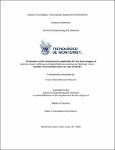| dc.contributor.advisor | Vázquez Lepe, Elisa Virginia | |
| dc.contributor.author | Meneses Ricaurte, Cindy Paola | |
| dc.date.accessioned | 2021-10-15T19:05:19Z | |
| dc.date.available | 2021-10-15T19:05:19Z | |
| dc.date.created | 2020-06 | |
| dc.date.issued | 2020-06-16 | |
| dc.identifier.citation | Meneses Ricaurte, C. P. (16 de 06 de 2020). Evaluation of the dimensional capabilities for the technologies of selective laser melting and digital light processing, to fabricate micro-cavities: microneedle insert as case of study. (Tesis de mastría). Instituto Tecnológico y de Estudios Superiores de Monterrey. Recuperado de: https://hdl.handle.net/11285/640556 | es_MX |
| dc.identifier.uri | https://hdl.handle.net/11285/640556 | |
| dc.description | 268852 | es_MX |
| dc.description.abstract | Additive manufacturing technologies are nowadays a feasible resource in micro parts fabrication, which have a wide range of applications from medical industry to injection molding. These technologies allow fabrication of complex parts with a variety of geometries and sizes that ultimately gives a competitive advantage by letting the manufacturing of insert molds.
This research study the dimensional capabilities of selective laser melting and digital light processing to produce microneedle cavities from 500 μm to 2500 μm. An insert for microneedle was manufactured variating its bases geometries and successfully fabricated through selective laser melting at 0°, 45° and 90° orientations. Similarly, for the digital light processing technology, inserts for microneedle geometries were manufactured at 0° and 45° build surface orientation. It was found for the hexagonal base geometry, the best for both technologies with the lower dimensional errors, due to a common factor between processes called stair steeping.
By using a reduction in border and contour power, height dimensional accuracy of the microneedle insert was improved. There was a minimum error of 3% for 600 μm of nominal height corresponding to the fabricated insert by selective laser melting at 0°orientation of construction with the optimal design. | es_MX |
| dc.format.medium | Texto | es_MX |
| dc.language.iso | eng | es_MX |
| dc.publisher | Instituto Tecnológico y de Estudios Superiores de Monterrey | es_MX |
| dc.relation | ITESM | es_MX |
| dc.relation | CONACYT | es_MX |
| dc.relation.isFormatOf | versión publicada | es_MX |
| dc.rights | openAccess | es_MX |
| dc.rights.uri | http://creativecommons.org/licenses/by-nc-nd/4.0 | es_MX |
| dc.subject.classification | INGENIERÍA Y TECNOLOGÍA::CIENCIAS TECNOLÓGICAS::TECNOLOGÍA INDUSTRIAL::PROCESOS INDUSTRIALES | es_MX |
| dc.subject.lcsh | Technology | es_MX |
| dc.title | Evaluation of the dimensional capabilities for the technologies of selective laser melting and digital light processing, to fabricate microcavities: microneedle insert as case of study. | es_MX |
| dc.type | Tesis de Maestría / master Thesis | es_MX |
| dc.contributor.department | School of Engineering and Sciences | es_MX |
| dc.contributor.committeemember | Sandoval Robles, Jesús Alejandro | |
| dc.contributor.committeemember | Rodríguez González, Ciro Ángel | |
| dc.contributor.mentor | García López, Erika | |
| dc.identifier.orcid | https://orcid.org/0000-0002-1171-221X | es_MX |
| dc.subject.keyword | Microneedles | es_MX |
| dc.subject.keyword | Insert | es_MX |
| dc.subject.keyword | SLM | es_MX |
| dc.subject.keyword | DLP | es_MX |
| dc.subject.keyword | Orientation | es_MX |
| dc.subject.keyword | Dimensional accuracy | es_MX |
| dc.contributor.institution | Campus Monterrey | es_MX |
| dc.contributor.cataloger | emipsanchez/tolmquevedo | es_MX |
| dc.description.degree | Master of science with a major in manufacturing systems | es_MX |
| dc.identifier.cvu | 946394 | es_MX |
| dc.date.accepted | 2020-06-16 | |
| dc.audience.educationlevel | Estudiantes/Students | es_MX |
| dc.relation.impreso | 2020-06-16 | |
| dc.identificator | 7||33||3310||331003 | es_MX |



